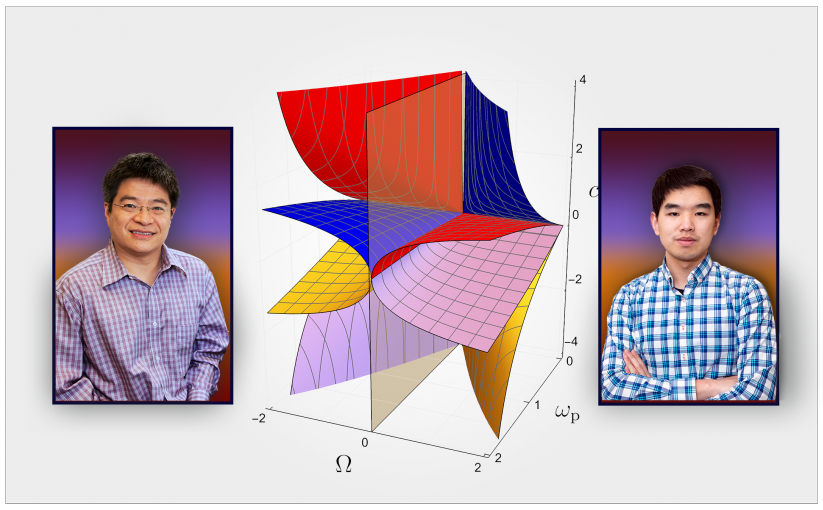A novel approach to classify magnetized plasmas has been found by the researchers and could probably result in progress in harvesting on Earth the fusion energy that drives the stars and the sun.
 Physicists Hong Qin, left, and Yichen Fu, with a rendering of 10 phases of plasma from their Nature Communications paper. Image Credit: Photos and collage by Elle Starkman/Office of Communications.
Physicists Hong Qin, left, and Yichen Fu, with a rendering of 10 phases of plasma from their Nature Communications paper. Image Credit: Photos and collage by Elle Starkman/Office of Communications.
The breakthrough achieved by theorists at the U.S. Department of Energy’s (DOE) Princeton Plasma Physics Laboratory (PPPL) reveals that a magnetized plasma features 10 special phases and the transitions between them may contain rich effects for practical growth.
The team discovered that the spatial boundaries, or transitions, between various phases will aid localized wave excitations.
These findings could lead to possible applications of these exotic excitations in space and laboratory plasmas. The next step is to explore what these excitations could do and how they might be utilized.
Yichen Fu, Study Lead Author and Graduate Student, Princeton Plasma Physics Laboratory
Fu was the lead author of the paper published in the journal Nature Communications that describes the research.
Potential Applications
Practical applications are making use of the excitations to produce current in magnetic fusion plasmas or enabling plasma rotation in fusion experiments.
Our paper doesn’t consider any practical application. The paper is the basic theory and the technology will follow the theoretical understanding.
Hong Qin, Study Co-Author and Physicist, Department of Astrophysical Sciences, Princeton University
“The discovery of the 10 phases in plasma marks a primary development in plasma physics. The first and foremost step in any scientific endeavor is to classify the objects under investigation. Any new classification scheme will lead to improvement in our theoretical understanding and subsequent advances in technology,” added Qin.
Qin, who is also Fu’s advisor, quotes the finding of the significant types of diabetes as an example of the role played by classification in scientific progress.
Qin added, “When developing treatments for diabetes, scientists found that there were three major types. Now medical practitioners can effectively treat diabetic patients.”
Fusion is something that researchers from all over the world are seeking to produce on Earth, and it integrates light elements in the form of plasma — the hot, charged state of matter formed of atomic nuclei and free electrons that constitutes 99% of the visible universe — to discharge enormous amounts of energy. Such energy could act as a clean, safe source of power for producing electricity.
The plasma phases unraveled by PPPL are technically called “topological phases,” denoting the shapes of the waves that plasma supports. Initially, this special property of matter was found in the field of condensed matter physics during the 1970s. It is a breakthrough for which Duncan Haldane, a physicist from Princeton University, shared the 2016 Nobel Prize for his innovative work.
Robust and Intrinsic
The localized plasma waves generated by phase transitions are intrinsic and strong since they are “topologically protected.”
Qin stated, “The discovery that this topologically protected excitation exists in magnetized plasmas is a big step forward that can be explored for practical applications.”
The most important progress in the paper is looking at plasma based on its topological properties and identifying its topological phases. Based on these phases we identify the necessary and sufficient condition for the excitations of these localized waves. As for how this progress can be applied to facilitate fusion energy research, we have to find out.
Yichen Fu, Study Lead Author and Graduate Student, Princeton Plasma Physics Laboratory
This work was financially supported by the DOE Office of Science (FES).
Journal Reference:
Fu, Y & Qin, H (2021) Topological phases and bulk-edge correspondence of magnetized cold plasmas. Nature Communications. doi.org/10.1038/s41467-021-24189-3.